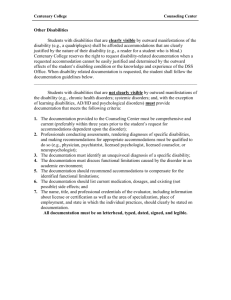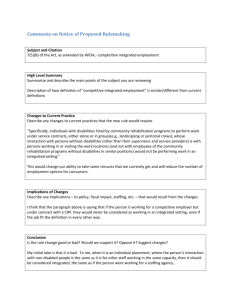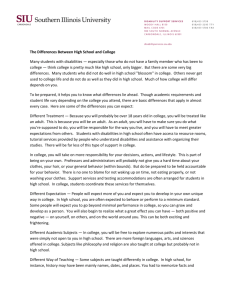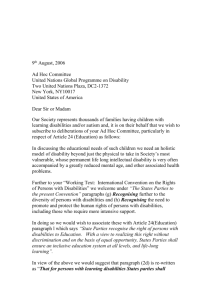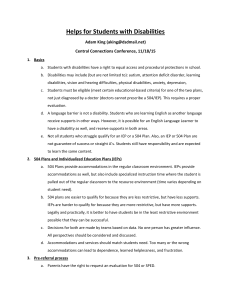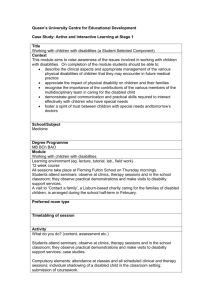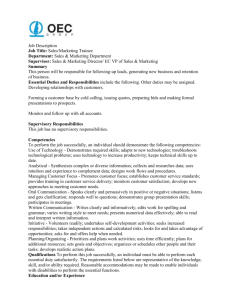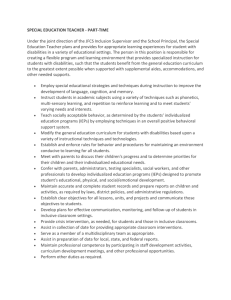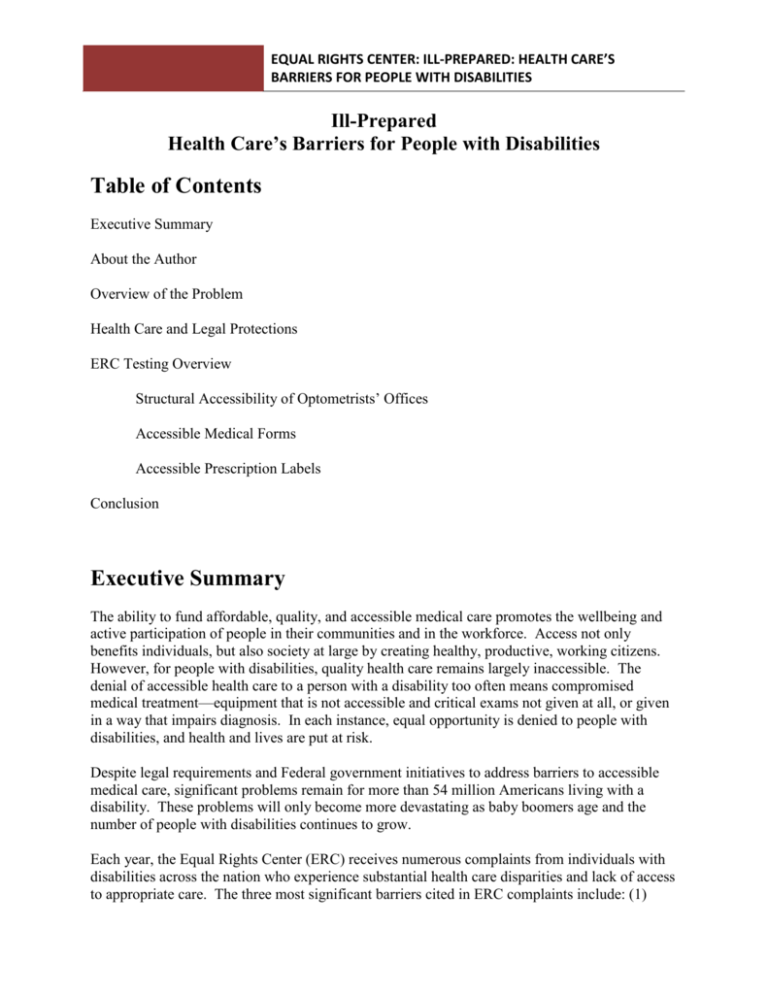
EQUAL RIGHTS CENTER: ILL-PREPARED: HEALTH CARE’S
BARRIERS FOR PEOPLE WITH DISABILITIES
Ill-Prepared
Health Care’s Barriers for People with Disabilities
Table of Contents
Executive Summary
About the Author
Overview of the Problem
Health Care and Legal Protections
ERC Testing Overview
Structural Accessibility of Optometrists’ Offices
Accessible Medical Forms
Accessible Prescription Labels
Conclusion
Executive Summary
The ability to fund affordable, quality, and accessible medical care promotes the wellbeing and
active participation of people in their communities and in the workforce. Access not only
benefits individuals, but also society at large by creating healthy, productive, working citizens.
However, for people with disabilities, quality health care remains largely inaccessible. The
denial of accessible health care to a person with a disability too often means compromised
medical treatment—equipment that is not accessible and critical exams not given at all, or given
in a way that impairs diagnosis. In each instance, equal opportunity is denied to people with
disabilities, and health and lives are put at risk.
Despite legal requirements and Federal government initiatives to address barriers to accessible
medical care, significant problems remain for more than 54 million Americans living with a
disability. These problems will only become more devastating as baby boomers age and the
number of people with disabilities continues to grow.
Each year, the Equal Rights Center (ERC) receives numerous complaints from individuals with
disabilities across the nation who experience substantial health care disparities and lack of access
to appropriate care. The three most significant barriers cited in ERC complaints include: (1)
EQUAL RIGHTS CENTER: ILL-PREPARED: HEALTH CARE’S
BARRIERS FOR PEOPLE WITH DISABILITIES
structural barriers in health care facilities, (2) inaccessible medical equipment, and (3) policies
and procedures that create barriers for patients with disabilities, such as inaccessible forms of
communication.
The alarming frequency of these complaints spurred the ERC to initiate a three-pronged series of
investigations concerning access to health care for people with disabilities. Conducting hundreds
of tests at locations across the nation, the ERC’s investigation reveals notable barriers in the
structural accessibility of doctors’ offices and equipment, and in effective communication for
individuals who are blind or have low vision.
Findings from ERC investigations include:
Only 20 percent of optometrists’ offices had the accessibility needed to perform an eye
exam on someone who uses a wheelchair;
Only 23 percent of doctors’ offices and hospitals offered patient information in large
print, and only 24 percent offered patient information in an accessible format; and
Only 1 percent of pharmacies offered information in Braille and only 1 percent offered
audible prescription bottles. In fact, 86 percent of tested pharmacies would not
accommodate the use of an audible prescription bottle even if provided by the customer.
These alarming statistics demonstrate why medical service and product providers must
acknowledge the uniquely important roles they play in the lives of people with disabilities and
change their methods of delivery to better accommodate this community.
About the Author
The Equal Rights Center (ERC)
Originally formed in 1983, the Equal Rights Center (ERC) is a national non-profit civil rights
organization based in Washington, D.C. With thousands of members located in all 50 states and
the District of Columbia, the ERC works nationally to promote equal opportunity in housing,
employment, disability rights, immigrant rights, LGBT rights and access to public
accommodations and government services for all protected classes under federal, state, and local
laws. With nearly three decades of experience as an advocate of the disability community, the
ERC has been a sounding board for scores of individual complaints about inaccessible health
care.
In its nearly thirty-year history, the ERC has developed an expertise in civil rights testing that
has been recognized by federal, state, and local governments, other civil rights organizations, and
the courts. The ERC conducts hundreds of civil rights tests each year to educate the public and
government officials of the endemic discrimination still faced by many individuals across
America. In 1990, Congress enacted the Americans with Disabilities Act (“ADA”) to ensure that
individuals with disabilities are given equal access and enjoyment of public accommodations,
EQUAL RIGHTS CENTER: ILL-PREPARED: HEALTH CARE’S
BARRIERS FOR PEOPLE WITH DISABILITIES
notwithstanding their disabilities. The ADA prohibits discrimination based on disability within
the United States. The law further requires public places and those providing services to the
public to make modifications in rules and policies to provide an equal service. The D.C. Human
Rights Act (“DCHRA”) insures that these protections are reflected in D.C.’s local law. The
ADA and the DCHRA are fully applicable to all private taxi companies in the District. These
laws require taxicab drivers to allow service dogs in their vehicles, and prohibit them from
discrimination.
The firm’s award-winning pro bono practice draws on the experience of its professionals
worldwide to improve the lives of those without access to justice or the means to hire lawyers,
and to meet the legal needs of charities and nonprofit social enterprises. The firm represents
individuals in this capacity, but also engages in policy advocacy and representations involving
multiple clients and larger entities to combat wide-scale injustice.
Overview of the Problem
Despite increasing efforts to ensure that all Americans are able to access appropriate and
adequate medical services, health care continues to be inaccessible for many with disabilities,
often with harmful consequences. People with disabilities experience both health disparities and
specific problems in gaining access to appropriate health care, including health promotion and
disease prevention programs and services.
As the population continues to grow and people live longer, the number of Americans that have a
disability is rapidly increasing. In 2005, 54.4 million individuals (18.7 percent) had some level
of disability, and 35.0 million (12.0 percent) had a severe disability.1 Rates of disability also
increase with age, with 41.9 percent of individuals over the age of 65 reporting a disability,
compared with 18.6 percent of people who are 16 to 64.2 Further, the numbers of older persons
are expected to grow substantially during the next several decades. It is estimated that by 2030,
the number of persons aged 65 years and older will rise to 71 million, from 34.7 million in 2000.
By 2030, the number of individuals aged 85 and older will also increase considerably, to 9.6
million, from 4.3 million in 2000.3
Disability is closely linked to health care use. People with disabilities:
1
Tend to be in poorer health and to use health care at significantly higher rates than people
who do not have disabilities;
Matthew Brault, Americans with Disabilities: 2005, CURRENT POPULATION REPORTS, (2008) at 3,
http://www.census.gov/prod/2008pubs/p70-117.pdf.
2
J. Waldrop and S. M. Stern, Disability Status: 2000-Census 2000 Brief, U.S. BUREAU OF THE CENSUS, at 2.
3
Institute of Medicine: Committee on Disability in America, The Future of Disability in America, (Field MJ, Jette AM
eds., National Academic Press) 2007
EQUAL RIGHTS CENTER: ILL-PREPARED: HEALTH CARE’S
BARRIERS FOR PEOPLE WITH DISABILITIES
Experience a higher prevalence of secondary conditions and use preventive services at
lower rates; and
Experience more problems accessing health care than other groups, and these difficulties
increase for those with the most significant disabilities and who are in the poorest health.
Moreover, lack of access to health care has been associated with increased risk for
secondary conditions for people with significant disabilities.4
People with disabilities experience a variety of barriers when accessing health care, including:
Stereotypes about disability on the part of healthcare providers;
Health care provider misinformation, and lack of appropriately trained staff;
Limited health care facility accessibility and lack of examination equipment that can be
used by people with varying disabilities;
Lack of sign language interpreters;
Lack of materials in formats that are accessible to people who are blind or have low
vision; and
Lack of individualized accommodations.5
At the national level, the scope of this crisis was recognized by the U.S. Department of Health
and Human Services, when it included reduction of health disparities affecting people with
disabilities as a priority in the “Healthy People 2010.” People with disabilities are represented in
over half of the “Healthy People 2010” focus areas.6
Similarly, in 2005, the national Surgeon General’s Call to Action to Improve the Health and
Wellness of Persons with Disabilities identified four specific goals for the nation to improve the
health and wellness of persons with disabilities:
GOAL 1: People nationwide understand that persons with disabilities can lead long,
healthy, productive lives.
GOAL 2: Health care providers have the knowledge and tools to screen, diagnose and
treat the whole person with a disability with dignity.
4
National Council on Disability, The Current State of Health Care for People with Disabilities, (2009),
http://www.ncd.gov/newsroom/publications/2009/HealthCare/HealthCare.html.
5
Id.
“Healthy People 2010,” is the government’s statement of national health objectives, designed to identify the
most significant preventable threats to health, and to establish national goals for reducing these threats. Healthy
People 2010, Objectives for Improving Health, Disability, and Secondary Conditions.
www.healthypeople.gov/Document/HTML/Volume1/06Disability.htm#_Toc486927298.
6
EQUAL RIGHTS CENTER: ILL-PREPARED: HEALTH CARE’S
BARRIERS FOR PEOPLE WITH DISABILITIES
GOAL 3: Persons with disabilities can promote their own good health by developing and
maintaining healthy lifestyles.
GOAL 4: Accessible health care and support services promote independence for persons
with disabilities.
“This Call to Action encourages health care providers to see and treat the whole person, not just
the disability; educators to teach about disability; a public to see an individual’s abilities, not just
his or her disability; and a community to ensure accessible health care and wellness services for
persons with disabilities.” - Surgeon General Richard H. Carmona, M.D., M.P.H., FACS.7
The Equal Rights Center regularly receives complaints regarding structural barriers at doctors’
offices, including inaccessibility of the actual facility, and the lack of accessible medical
equipment such as x-rays, examination tables, weight scales. Personal, real-life experiences
gathered by the ERC demonstrate that doctors’ offices are failing to provide the necessary care
and equipment. The following situations faced by ERC members are illustrative of the
problems:
A woman with quadriplegia, who has a history of breast cancer in her family, was denied
access to a mammogram screener and was told that nothing could be done to provide her
access to these services.
A man with quadriplegia was denied an accessible exam table and scale at his medical
clinic, which were necessary for him to receive the same quality of care as other patients.
His doctors used height and weight records that were ten years old to determine what
dosages of medication to prescribe.
A woman who uses a wheelchair was unable to find a doctor’s office where she could
access the examination table for a pelvic exam. Only after nearly a year of searching did
she find an office where she could be examined, at which time she was diagnosed with
endometrial cancer.
These stories are indicative of a large and widespread problem. A national survey revealed
alarming statistics, reporting that a majority of people with disabilities experience difficulty in
navigating medical facilities and undergoing medical exams.8 Of 408 people surveyed:
7
75 percent experienced difficulty navigating exam tables, such that 32 percent had
moderate problems, 34 percent had extreme difficulty, and 9 percent said they were
impossible to use. Problems reported included height and width, nothing to hold onto
when getting on the table, nothing to lean on once on the table, and hard-to-use stirrups.
U.S. Department of Health and Human Services. The Surgeon General’s Call to Action to Improve the Health and
Wellness of Persons with Disabilities. U.S. DEPARTMENT OF HEALTH AND HUMAN SERVICES, OFFICE OF THE
SURGEON GENERAL, (2005).
8
Kailes, June Isaacson. Just hop up, look here, read this, listen up, don’t breath and stay still! Access to medical
equipment – Where are we?, (lecture presented at the webcast for Independent Living Research Utilization
program, Houston, TX, January 4, 2007).
EQUAL RIGHTS CENTER: ILL-PREPARED: HEALTH CARE’S
BARRIERS FOR PEOPLE WITH DISABILITIES
68 percent experienced difficulty in accessing x-ray equipment, such that 41 percent had
moderate difficulty, 32 percent had extreme difficulty, and 4 percent said it was
impossible to use. This equipment included general x-rays, mammograms, MRIs,
ultrasounds, and other types of medical scans.
54 percent experienced difficulty in using the medical facilities’ weight scales, such that
25 percent had moderate difficulty, 17 percent had extreme difficulty, and 13 percent said
they were impossible to use.
50 percent found it difficult to use examination chairs, such that 30 percent had moderate
difficulty, 17 percent had extreme difficulty, and 4 percent said they were impossible to
use. These chairs included those relied on for dental exams, oral surgery, eye exam, and
laboratory work.9
Moreover, the ERC receives complaints related to accessible medical forms and health care
communication. Complaints include:
A woman who is blind was unable to obtain from her health insurance provider an
accessible form detailing her policy. When she requested Braille forms be mailed to her,
so that she could fully understand the type and scope of her medical care coverage, they
refused to provide her an accessible form.
A woman who is blind had problems accessing her physicians’ offices because they did
not have Braille signage on their doors and elevators. The woman would often walk into
the wrong doctor’s office or end up on the wrong floor because she did not know where
she was going due to the lack of Braille signage.
A Deaf teenager was denied an American Sign Language interpreter for his doctor’s
appointment. The physician’s office stated that the family was responsible for hiring their
own interpreter or communicating for him.
Inaccessible health care does not end at hospitals and doctors’ offices. The ERC also receives
complaints from its members who are blind or low vision regarding inaccessible prescription
labels. For example:
9
Id.
A woman who is blind found that many pharmacies do not provide her medication with a
Braille option. She expressed frustration because she had to rely on her mother to
purchase her medication and explain when to take it. The inability for patients to see how
much medication to take and when to take it can cause disastrous results that could easily
be remedied if prescription labels were accessible to all people.
A woman who is blind was required to answer confidential medical questions which were
read aloud to her by office personnel in a busy waiting room, rather than providing her a
private space or an electronic version she could complete by herself. Failure to secure
confidentiality discourages the candid communication between patient and medical
provider that is needed for effective treatment.
EQUAL RIGHTS CENTER: ILL-PREPARED: HEALTH CARE’S
BARRIERS FOR PEOPLE WITH DISABILITIES
These situations illustrate a severe and systemic issue. The problems facing people with
disabilities when accessing health care are wide-ranging and very serious. As noted by one
group of accessibility experts:
Evidence shows that many people with disabilities often receive substandard
healthcare. Many complex factors contribute to this reality, including limitations
on services by insurers, discriminatory practices and policies by healthcare
providers, and widespread lack of awareness about disability within the healthcare
industry as a whole…. Responsibility for identifying and initiating effective
strategies that build on the principles of the ADA and that will lead to a shift in
the current approach to healthcare delivery for people with disabilities rests with
diverse stakeholders.10
Health Care and Legal Protections
The landmark 1990 Americans with Disabilities Act (ADA), and Section 504 of the
Rehabilitation Act of 1973 (Section 504), established wide-ranging national mandates
prohibiting discrimination based on disability. Collectively, these two vital laws prohibit public
and private health care providers from discriminating against people with disabilities, and ensure
equal opportunity to participate in and benefit from health care services.
Under Federal law, a person is defined as having a disability when he or she: (a) has a physical
or mental impairment11 that substantially limits one or more major life activities; (b) has a record
of such an impairment; or (c) is regarded as having such an impairment. Under the 2008 ADA
Amendments, major life activities include, but are not limited to: seeing, walking, and learning,
as well as the operation of major bodily functions – like the immune system. The Amendments
also make clear that the ADA covers people with episodic conditions, such as epilepsy. Today, a
person is protected under the ADA if he or she has a disability that substantially limits a life
activity when the condition is in an active state, even if the condition is not evident or does not
limit a life activity at all times.12
Section 504 of the Rehabilitation Act
The first Federal civil rights law protecting individuals with disabilities was the Rehabilitation
Act of 1973. Section 504 of this Act prohibits discrimination against otherwise qualified people
with disabilities under any program or activity that receives Federal financial assistance.13 It
10
J. Panko Reis, M. L. Breslin, L. I. Iezzoni, and K. Kirscher, It Takes More Than Ramps to Solve the Healthcare Crisis
for People with Disabilities (Chicago: Rehabilitation Institute of Chicago, 2004) at 42.
11
Americans with Disabilities Act, 42 U.S.C. §12102 (1990), amended by the Americans with Disabilities
Amendments Act, Pub. L. No. 110-325 (2008).
12
13
Id.
Rehabilitation Act, 29 U.S.C. §794 (1973).
EQUAL RIGHTS CENTER: ILL-PREPARED: HEALTH CARE’S
BARRIERS FOR PEOPLE WITH DISABILITIES
directly applies to state Medicaid agencies as well as health care entities and providers that
receive Federal monies through Medicaid, Medicare, or Federal block grants. In the medical
setting, the Rehabilitation Act is frequently applied since the vast majority of health care
providers accept Medicaid and Medicare funds from the Federal government. 14
The Americans with Disabilities Act
The ADA, enacted in 1990, provides protections from discrimination for individuals with
disabilities. Titles II and III of the ADA also prohibit disability discrimination and require health
care providers to be physically and programmatically accessible to people with disabilities.15
Title II of the ADA prohibits discrimination by public entities run or funded by state and local
governments. These include any department, agency, special purpose district, or other
instrumentality of a state or local government, including community health clinics or state run
hospitals.16
Title III of the ADA prohibits any public accommodation from discriminating against individuals
with disabilities by denial of access to goods and services. Public accommodations include all
areas open to the public, including restaurants, stores, banks, pharmacies, legal offices, doctors’
offices and hospitals. Title III states that “private entities are considered public accommodations
for purposes of this title, if the operations of such entities affect commerce” and specifically
includes “professional office of a health care provider, hospital, or other service
establishment.”17
Under Title III, discrimination includes:
Establishment of eligibility criteria that screen out individuals with disabilities from
equally benefiting from a good or service;
Failure to make reasonable modifications in policies, practices, or procedures when such
modifications are necessary to ensure that individuals with disabilities have access to the
goods or services;
Failure to take such steps as may be necessary to ensure that no individual with a
disability is excluded, denied services, or treated differently because of the absence of
auxiliary aids and services;
Failure to remove architectural barriers; and failure to make a good or service available
through alternative methods if such methods are readily achievable.18
The purpose of Title III is to ensure that no person with a disability is denied goods or services
offered to the public because of their disability. This language makes clear that it is unlawful for
14
Id.
42 U.S.C. §§12101, et seq.
16
42 U.S.C. §12115.
17
42 U.S.C. §12181.
18
Id.
15
EQUAL RIGHTS CENTER: ILL-PREPARED: HEALTH CARE’S
BARRIERS FOR PEOPLE WITH DISABILITIES
a privately run hospital or doctor’s office to make its goods or services unavailable to people
with disabilities as a result of a failure to take the necessary steps to ensure equal access. Under
both Titles II and III, medical facilities must ensure that their goods and services are accessible
to people with disabilities.
One component of accessibility is the elimination of “structural barriers” that deny access to
people with disabilities. Structural barriers are tangible components of buildings that make it
difficult or impossible for a person with a disability to enter and maneuver about a space
effectively and safely, such as stairs.19
Another aspect of accessibility is the willingness to make accommodations for people with
disabilities. Reasonable accommodations are modifications in a procedure, practice, or policy,
which allow individuals with disabilities to equally benefit from the goods or services being
offered.20
Finally, public entities must provide auxiliary aids and services to ensure effective
communication between medical staff and patients.21 Auxiliary aids and services may include
hiring an ASL Interpreter for a doctor’s appointment, or providing documents in alternative
formats to individuals who are blind or low vision.
Structural barriers in medical facilities prevent people with disabilities from getting proper
diagnoses and treatment. Under federal law, including accessibility standards such as the ADA
Accessibility Guidelines, medical facilities must be free from structural barriers and meet certain
accessibility standards. These standards include but are not limited to:
Accessible entrances with no stairs;
Doors that are wide enough to ensure safe passage by individuals using mobility aids;
Paths of travel throughout buildings that are accessible;
Restrooms that have grab bars and accessible sinks;
Items such a water fountains, pay phones, and service counters low enough to be within
reach for an individual with a mobility disability or short stature; and
Braille signage on elevators and restrooms.22
Medical facilities must provide auxiliary aids and services to ensure effective communication
between medical staff and patient. Auxiliary aids are services or devices that enable persons
with impaired sensory, manual, or speaking skills to communicate effectively and have an equal
opportunity to participate in, and enjoy the benefits of, programs or activities conducted by the
19
20
42 U.S.C. §12182(b)(2)(A).
Id.
Id
22
Department of Justice. 2010 ADA Standards for Accessible Design. 28 CFR part 36, (2010).
21
EQUAL RIGHTS CENTER: ILL-PREPARED: HEALTH CARE’S
BARRIERS FOR PEOPLE WITH DISABILITIES
entity.23 In the medical setting, auxiliary aids and services may include hiring an American Sign
Language Interpreter for a doctor’s appointment or providing documents in alternative formats to
individuals who are blind or low vision.
Medical facilities do not have to make accommodations or provide auxiliary aids and services
when doing so would be an undue hardship or when an accommodation would be a fundamental
alteration in the nature of the goods or services provided.24 Whether or not an accommodation
constitutes an undue hardship depends on a variety of factors, including the cost of the
accommodation relative to size of the business.25 For example, a large hospital located next to a
deaf university may be required to ensure that qualified American Sign Language Interpreters are
available or can be made available at any time. However, for a small doctor’s office with two
physicians, ensuring immediate access to an interpreter may be an undue burden. While the
doctor’s office is still responsible for providing an auxiliary aid, another option may be to
provide interpreters when a patient requests the communication aid in advance.
Likewise, a medical provider is not required to make an accommodation if doing so would be a
fundamental alteration in the nature of the goods or services provided. For example, the primary
care physician of an individual who uses a wheelchair is not required to treat a patient for cancer,
even if the patient requests. To treat the cancer would be a fundamental alteration in the nature
of the services the primary care physician would normally provide. The primary care physician
is required to make an appropriate referral to an oncologist, as he or she would for any other
patient.
Finally, health care providers located in buildings that have been completed or undergone
significant alterations since 1993 must be designed and constructed so that they are fully
accessible. Facilities operating in buildings build prior to 1993 are required to remove
architectural barriers such as steps, narrow doorways, and inaccessible toilets if doing so is
“readily achievable.” Such alterations are considered “readily achievable”26 if they can be carried
out without too much difficulty or expense.27
Health Care Reform
The recently passed health care reform law, The Patient Protection and Affordable Care Act, has
the promise of making quality health care more accessible for all Americans, including people
with disabilities.28
23
28 C.F.R. § 36.303 .
42 U.S.C. §12182(b)(2)(A)(ii)(iii).
25
42 U.S.C. §12181(9).
26
42 U.S.C. §12182(b)(1)(A).
27
42 U.S.C. §12181(9)
28
The Patient Protection and Affordable Care Act, Pub. L. No. 111-148, 124 Stat. 119-124 (2010), as amended by
the Health Care and Education Reconciliation Act, Pub. L. No. 111-152, 124 Stat. 1029-1084 (2010).
24
EQUAL RIGHTS CENTER: ILL-PREPARED: HEALTH CARE’S
BARRIERS FOR PEOPLE WITH DISABILITIES
Of relevance to this report, health care reform will affect people with disabilities in the following
ways:
As of 2014, health insurance providers will no longer be able to discriminate against
people due to disability or any other pre-existing condition;
The U.S. Access Board, in consultation with the Food and Drug Administration, is
required to establish regulatory standards setting the minimum technical criteria for
accessible medical diagnostic equipment for people with disabilities. While existing law
requires medical equipment to be accessible, these standards are intended to clarify how
to comply with this requirement;
Medical professionals are required to receive disability awareness training to help reduce
the health disparities that exist for people with disabilities; and
Except as provided elsewhere in the law, discrimination based on disability is prohibited
under any health program or activity which receives Federal assistance, including credits,
subsidies, contracts of insurance, or under any program or activity that is administered by
an Executive Agency. Section 504 of the Rehabilitation Act provides enforcement
mechanisms for violations.
Other Legal Protections
In addition to federal protections, many states, as well as some counties and cities, also have
disability nondiscrimination laws that apply to health care providers, including individual
practitioners, nonprofit and commercial hospitals, and HMOs.29 In the District of Columbia, The
DC Human Rights Act forbids DC government entities and all public accommodations from
discriminating against individuals due to disability.30
The Equal Rights Center’s Testing of the Availability of
Accessible Medical Care
After receiving complaints from ERC members regarding inaccessible medical facilities and the
lack of appropriate accommodations in doctors’ offices and pharmacies, the ERC sought to
determine the extent to which these anecdotal stories were indicative of larger problems across
the country. Responding to specific complaints, the ERC commenced a three-pronged
investigation to gather information on the prevalence of discrimination in health care settings.
The ERC’s investigation studied and measured:
29
See, e.g., California’s Unruh Civil Rights Act as applied in Washington v. Blampin, 226 CA2d 604, 38 CR 235
(1964). The Act’s broad language of “services in all business establishments of every kind whatsoever” was
intended to cover the professions. See Leach v. Drummond Med. Group, 144 CA3d 362, 269, 370 (1930), in which
the Act is applied to a corporate medical group that refused future medical services to plaintiffs with disabilities.
30
DC Human Rights Act, D.C. Code §2-1402.73, §2-1402.31.
EQUAL RIGHTS CENTER: ILL-PREPARED: HEALTH CARE’S
BARRIERS FOR PEOPLE WITH DISABILITIES
Structural accessibility in optometrists’ offices;
Accommodations in doctors’ offices for individuals who are blind or have low vision;
and
Accommodations in pharmacies for individuals who are blind or have low vision.
Structural Accessibility of Optometrists’ Offices
Structural inaccessibility is a barrier to countless people with disabilities. Individual
complainants reported difficulty not only entering the offices and maneuvering around, but also
getting a complete exam due to the lack of equipment needed to perform eye exams on
individuals seated in wheelchairs.31
In the first prong of its investigation, the ERC sought to determine if individuals who use
wheelchairs would encounter barriers while attempting to get an eye exam. The ERC measured
if facilities themselves were structurally accessible, and if the medical equipment used by retail
optometrist offices was adaptable for people with disabilities. The testing methodology for this
prong relied largely on self-reporting. Testers posed as potential consumers who were calling in
advance of scheduling an appointment to see if they would be able to access the facilities.
ERC testing revealed that optometric medical facilities routinely lack the equipment to provide
services to people with disabilities. Of the fifteen locations tested for wheelchair accessibility,
only three had the necessary equipment to provide an eye exam to an individual in a wheelchair.
Twelve out of fifteen (80 percent) lacked the accessibility needed to provide an individual in a
wheelchair an eye exam. Although some of this inaccessibility stemmed from the structural
inaccessibility of the office itself, the biggest accessibility barrier was the inability to provide an
eye exam to someone seated in a wheelchair.
Accessible Medical Forms
The ERC also receives complaints from individuals who encounter difficulty in accessing their
personal medical information, and filling out forms at doctors’ offices. People with visual
disabilities and mobility disabilities experienced humiliation when going to a doctor for the first
time and being unable to fill out forms regarding medical history and health insurance in a
confidential setting. People with visual disabilities also report numerous attempts to obtain
information regarding their health and being unable to do so because of the lack of accessible
documents.
31
For example, many phoropters used by optometrists to test visual acuity are not designed to be lowered to
accommodate a person using a wheelchair. Absent the ability to transfer into an exam chair, this critical diagnostic
equipment is not accessible.
EQUAL RIGHTS CENTER: ILL-PREPARED: HEALTH CARE’S
BARRIERS FOR PEOPLE WITH DISABILITIES
Medical facilities must make accommodations for people with disabilities so long as the
accommodation is not a fundamental alteration in the nature of the goods and services provided
and does not pose an undue burden on the medical facility.
The second prong of the ERC’s investigation was designed to determine the availability of
alternative formats for medical information at doctors’ offices and hospitals. The ERC tested
four different types of medical facilities, doctors’ offices for the practice of: (a) internal
medicine, (b) ophthalmology, (c) dermatology, and (d) hospitals. All of the doctors’ offices
surveyed were privately run with a staff of no less than three physicians. The ERC conducted
100 tests, testing each of the four types of medical providers in 24 states and the District of
Columbia.32
In this study, the ERC again relied largely on self-reporting by the medical services provider
themselves. Surveyors called doctors’ offices posing as potential patients and inquired: (1) if
the office provides information in alternative formats; (2) the easiest way to fill out patient
history forms prior to a visit, or (3) if there was an accommodation in place to fill out the forms
at the doctors’ office.
The results of this study, unfortunately, confirm that doctors’ offices routinely fail to provide
necessary accommodations to individuals who are blind or have low vision. The results
included:
Of the 25 internal medicine offices tested, only 20 percent offered documents in large
print and only 12 percent offered documents in an accessible electronic format.
Of the 25 ophthalmology offices tested, only 20 percent offered documents in large print
and 20 percent offered documents in an accessible electronic format.
Dermatology offices were slightly better in that 32 percent offered documents in large
print and 40 percent offered accessible electronic documents.
A much larger percentage of offices offered alternative accommodations to people with visual
disabilities. However, many of these alternatives failed to provide the individual with a
disability the same quality of service as a sighted individual. For example, many doctor’s offices
stated that a receptionist or nurse could assist in filling out forms. While at first, this
accommodation may seem adequate, numerous reports from ERC members indicated that office
staffs fail to provide assistance in a way that ensures the patient’s confidentiality. Another
accommodation offered by doctors’ offices was the willingness to mail forms to the patient prior
to their appointment. Again, while this may seem acceptable at first, since it assures that the
forms can be filled out ahead of time, it still requires that the patient seek the assistance of a
sighted individual in order to complete the forms.
32
Tests were conducted in Arizona, California, Colorado, Connecticut, Florida, Illinois, Indiana, Maryland,
Massachusetts, Mississippi, Nebraska, Nevada, New York, North Carolina, Ohio, Oklahoma, Pennsylvania,
Tennessee, Texas, Utah, Virginia, Washington, Wisconsin, Wyoming.
EQUAL RIGHTS CENTER: ILL-PREPARED: HEALTH CARE’S
BARRIERS FOR PEOPLE WITH DISABILITIES
The testing of hospitals proved to be very challenging. Of the 25 tests conducted, the tester was
transferred among hospital staff 68% of the time, and approximately 30 percent of the time never
spoke with an individual who could answer their questions. In the instances where answers were
provided, only 20 percent of hospitals offered large print materials and only 24 percent offered
documents in an accessible electronic format.
Accessible Prescription Labels
ERC members with visual disabilities frequently report that prescription labels are inaccessible,
creating problems determining what medications are theirs, the expiration dates for the drugs,
and dosage information. Included in the complaints are concerns of being unable to identify
medication by pill texture, shape, or size, resulting in erroneous dosing or unintended
combinations of prescriptions.
Under the Section 504 and the ADA, pharmacies are required to be structurally accessible and
provide accommodations and auxiliary aids to ensure equal access and effective communication.
Auxiliary aids are services and devices used to ensure effective communication by an individual
who has a disability. The failure of pharmacies to provide prescription labels in alternative
formats thus violates federal law.
The third prong of the ERC’s investigation was designed to study the availability of prescription
labels in alternative formats. The ERC examined the practices of four major prescription
retailers by conducting 100 tests in 24 states and the District of Columbia.33
The ERC’s investigation sought to determine whether pharmacies had the capability to label
bottles and provide medication information in alternative formats in order to be accessible to
people who are blind or have low vision. Testers were instructed to specifically ask about the
availability of Braille, audible bottles,34 as well as any other accommodations the store may
offer. The ERC’s study demonstrated that:
33
Only 1 percent of all retailers offered any information in Braille.
Only 1 percent of retailers could provide audible bottles.
Eighty-six percent were unable to accommodate a customer with audible bottles, even if
the customer provided the bottles.
Fifteen percent of pharmacies did not offer any accommodations or suggestions for how
someone with a visual disability could get prescriptions labeled in alternative formats.
Tests were conducted in Arizona, California, Colorado, Connecticut, Florida, Illinois, Indiana, Maryland,
Massachusetts, Mississippi, Nebraska, Nevada, New York, North Carolina, Ohio, Oklahoma, Pennsylvania,
Tennessee, Texas, Utah, Virginia, Washington, Wisconsin, Wyoming
34
“Audible bottles” are prescription bottles that have a device affixed to them that provide information regarding
the medication audibly to assist individuals with disabilities.
EQUAL RIGHTS CENTER: ILL-PREPARED: HEALTH CARE’S
BARRIERS FOR PEOPLE WITH DISABILITIES
The accommodations and recommendations of the other 85 percent of pharmacies varied greatly.
Many pharmacies recommended that the person call another pharmacy, or recommended that the
tester get a personal aid, or have a family member assist with medication. Other pharmacies took
a more proactive approach and offered to work with the person and provide different sized
bottles and direct consultation, or assist the person in distributing their medication into monthly
pill planners.
These four major retailers represent nearly 20,000 stores nationwide, a substantial share of the
total pharmacies in the United States. This is especially troubling since the ERC testing reveals
that there is no protocol in place to provide accommodations to individuals who are blind or have
low vision. The inability of individuals who are blind or have low vision to access their own
medication exemplifies the challenges people with disabilities face in trying to obtain effective
health care.
Conclusion
The availability of accessible medical services, medical forms, and prescription drugs plays a
uniquely vital role in the lives of people with disabilities. The Equal Rights Center’s testing
investigations and the many experiences of ERC members show that this community is, at best,
given second-class treatment.
Notwithstanding the promises of equal opportunities for people with disabilities mandated by
both the ADA and Section 504, individuals across the nation are still denied adequate and
necessary health care every day due to their disabilities. With more than 54 million Americans
living with disabilities, a number that is rapidly expanding, the continued widespread
discrimination against people with disabilities in the area of health care is unacceptable.
The Equal Rights Center hopes that as a result of the findings in this study, disability rights
advocates, government enforcement agencies, and community leaders will continue to promote
equal access to rectify this type of discrimination against people with disabilities. Through a
coordinated, concerted effort to respond to these issues, providers of health care services and
products have the opportunity to transform their current compliance with these laws from an
embarrassment into a model of equal opportunity for the disability community.
The Equal Rights Center
11 Dupont Circle, N.W.
Suite 450
Washington, D.C. 20036
www.equalrightscenter.org
EQUAL RIGHTS CENTER: ILL-PREPARED: HEALTH CARE’S
BARRIERS FOR PEOPLE WITH DISABILITIES
November 2011
© Equal Rights Center - 2010 All Rights Reserved

